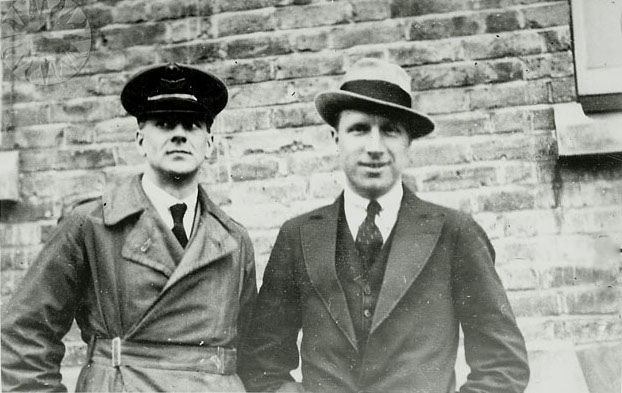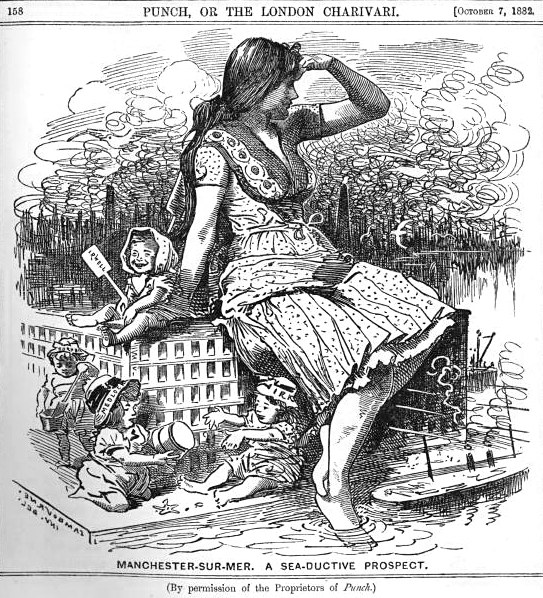|
Trafford Park Aerodrome (Manchester)
Trafford Park Aerodrome (Manchester) was the first purpose-built airfield in the Manchester area. Its large all-grass landing field was just south of the Manchester Ship Canal between Trafford Park Road, Moseley Road and Ashburton Road and occupied a large part of the former deer park of Trafford Hall. Today's Tenax Road runs north–south through the centre of the site of the old airfield, which was 0.7 miles northeast of today's Trafford Centre. Operations in 1911–1912 Manchester Aerodrome Ltd was formed in late 1910 to rent the land and prepare the surface for flying and this work was completed by summer 1911. The first known use of Trafford Park airfield was by Henry Melly on 7 July 1911 when he flew his Blériot monoplane, with A. Dukinfield-Jones as passenger, from his base at Waterloo just north of Liverpool to meet Alliott Verdon Roe for lunch at Trafford Hall. By prior arrangement, A.V. Roe had laid out white sheets on the aerodrome to indicate the location of th ... [...More Info...] [...Related Items...] OR: [Wikipedia] [Google] [Baidu] |
Manchester
Manchester () is a city in Greater Manchester, England. It had a population of 552,000 in 2021. It is bordered by the Cheshire Plain to the south, the Pennines to the north and east, and the neighbouring city of Salford to the west. The two cities and the surrounding towns form one of the United Kingdom's most populous conurbations, the Greater Manchester Built-up Area, which has a population of 2.87 million. The history of Manchester began with the civilian settlement associated with the Roman fort ('' castra'') of ''Mamucium'' or ''Mancunium'', established in about AD 79 on a sandstone bluff near the confluence of the rivers Medlock and Irwell. Historically part of Lancashire, areas of Cheshire south of the River Mersey were incorporated into Manchester in the 20th century, including Wythenshawe in 1931. Throughout the Middle Ages Manchester remained a manorial township, but began to expand "at an astonishing rate" around the turn of the 19th century. Manchest ... [...More Info...] [...Related Items...] OR: [Wikipedia] [Google] [Baidu] |
1911 Establishments In England
A notable ongoing event was the race for the South Pole. Events January * January 1 – A decade after federation, the Northern Territory and the Australian Capital Territory are added to the Commonwealth of Australia. * January 3 ** 1911 Kebin earthquake: An earthquake of 7.7 moment magnitude strikes near Almaty in Russian Turkestan, killing 450 or more people. ** Siege of Sidney Street in London: Two Latvian anarchists die, after a seven-hour siege against a combined police and military force. Home Secretary Winston Churchill arrives to oversee events. * January 5 – Egypt's Zamalek SC is founded as a general sports and Association football club by Belgian lawyer George Merzbach as Qasr El Nile Club. * January 14 – Roald Amundsen's South Pole expedition makes landfall, on the eastern edge of the Ross Ice Shelf. * January 18 – Eugene B. Ely lands on the deck of the USS ''Pennsylvania'' stationed in San Francisco harbor ... [...More Info...] [...Related Items...] OR: [Wikipedia] [Google] [Baidu] |
Airports In Greater Manchester
An airport is an aerodrome with extended facilities, mostly for commercial air transport. Airports usually consists of a landing area, which comprises an aerially accessible open space including at least one operationally active surface such as a runway for a plane to take off and to land or a helipad, and often includes adjacent utility buildings such as control towers, hangars and terminals, to maintain and monitor aircraft. Larger airports may have airport aprons, taxiway bridges, air traffic control centres, passenger facilities such as restaurants and lounges, and emergency services. In some countries, the US in particular, airports also typically have one or more fixed-base operators, serving general aviation. Operating airports is extremely complicated, with a complex system of aircraft support services, passenger services, and aircraft control services contained within the operation. Thus airports can be major employers, as well as important hubs for tourism ... [...More Info...] [...Related Items...] OR: [Wikipedia] [Google] [Baidu] |
Defunct Airports In England
{{Disambiguation ...
Defunct (no longer in use or active) may refer to: * ''Defunct'' (video game), 2014 * Zombie process or defunct process, in Unix-like operating systems See also * * :Former entities * End-of-life product * Obsolescence Obsolescence is the state of being which occurs when an object, service, or practice is no longer maintained or required even though it may still be in good working order. It usually happens when something that is more efficient or less risky r ... [...More Info...] [...Related Items...] OR: [Wikipedia] [Google] [Baidu] |
Farman
Farman Aviation Works (french: Avions Farman) was a French aircraft company founded and run by the brothers Richard, Henri, and Maurice Farman. They designed and constructed aircraft and engines from 1908 until 1936; during the French nationalization and rationalization of its aeronautical industry, Farman's assets were assigned to the ''Société Nationale de Constructions Aéronautiques du Centre'' (SNCAC). In 1941 the Farman brothers reestablished the firm as the "''Société Anonyme des Usines Farman''" (SAUF), but only three years later it was absorbed by Sud-Ouest. Maurice's son, Marcel Farman, reestablished the SAUF in 1952, but his effort proved unsuccessful and the firm was dissolved in 1956. The Farman brothers designed and built more than 200 types of aircraft between 1908 and 1941. They also built cars until 1931 and boats until 1930. Background In 1907, Henri Farman bought his first aircraft from Gabriel Voisin and soon began to improve the design of the air ... [...More Info...] [...Related Items...] OR: [Wikipedia] [Google] [Baidu] |
John Alcock (RAF Officer)
Captain Sir John William Alcock (5 November 189218 December 1919) was a British Royal Navy and later Royal Air Force officer who, with navigator Lieutenant Arthur Whitten Brown, piloted the first non-stop transatlantic flight from St. John's, Newfoundland to Clifden, Ireland in June 1919. He died in a flying accident in France in December later that same year. Early life John Alcock was born on 5 November 1892, perhaps in the coach-house adjoining Basford House on Seymour Grove, Firswood, Manchester, England. He attended Heyhouses School in Lytham St. Annes. He first became interested in flying at the age of 17. His first job was at the Empress Motor Works in Manchester. In 1910 he became an assistant to Works Manager Charles Fletcher, an early Manchester aviator and Norman Crossland, a motor engineer and founder of Manchester Aero Club. It was during this period that Alcock met the Frenchman Maurice Ducrocq who was both a demonstration pilot and UK sales representative f ... [...More Info...] [...Related Items...] OR: [Wikipedia] [Google] [Baidu] |
Louis Strange
Louis Arbon Strange, (27 July 1891 – 15 November 1966) was an English aviator, who served in both World War I and World War II. Early life Louis Strange was born in Tarrant Keyneston, Dorset, and was educated at St Edward's School, Oxford, joining the school's contingent of the Dorset Yeomanry. Strange spent his childhood at Tarrant Keynstone Mill on the River Stour. His family farmed at Spetisbury in Dorset. He had seen military aircraft and the airship Beta flying over Dorset during the summer manoeuvres of 1912 when serving with the Dorsetshire Yeomanry and determined in May 1913 to become a pilot. He joined the Ewen School of flying at Hendon Aerodrome in July and gained his Royal Aero Club Aviators' Certificate, No. 575, on 5 August. On 8 October 1913 he was commissioned as a second lieutenant (on probation) in the Royal Flying Corps (Special Reserve). Just after obtaining his licence he won his first cross-country race and then won the Hendon March Meeting race, be ... [...More Info...] [...Related Items...] OR: [Wikipedia] [Google] [Baidu] |
Mottram Hall
Mottram Hall (also known as Mottram New Hall or the Mottram Hall Hotel) is a former country house to the northeast of the village of Mottram St. Andrew, Cheshire, England. It is recorded in the National Heritage List for England as a designated Grade II* listed building. It is not to be confused with Mottram Old Hall (alongside the access road 400m to the west). The house was built around 1750 by William Wright for his son. It is constructed of Flemish bond orange brick with buff sandstone dressings, with a Kerridge stone slate roof, nine brick chimneys, and a facade with projecting end pavilions which have 20th-century extensions. From the mid-1970s the building has been used as a hotel, and from 2014 to 2018 as part of the QHotels group. In 2012–13 the hotel underwent improvements and refurbishment at a cost of £5.5 million. This included a new restaurant, refurbishment of bedrooms, creation of conference suites, and restoration of the Garden Suite. In Septemb ... [...More Info...] [...Related Items...] OR: [Wikipedia] [Google] [Baidu] |
Manchester Ship Canal
The Manchester Ship Canal is a inland waterway in the North West of England linking Manchester to the Irish Sea. Starting at the Mersey Estuary at Eastham, near Ellesmere Port, Cheshire, it generally follows the original routes of the rivers Mersey and Irwell through the historic counties of Cheshire and Lancashire. Several sets of locks lift vessels about to the canal's terminus in Manchester. Landmarks along its route include the Barton Swing Aqueduct, the world's only swing aqueduct, and Trafford Park, the world's first planned industrial estate and still the largest in Europe. The rivers Mersey and Irwell were first made navigable in the early 18th century. Goods were also transported on the Runcorn extension of the Bridgewater Canal (from 1776) and the Liverpool and Manchester Railway (from 1830), but by the late 19th century the Mersey and Irwell Navigation had fallen into disrepair and was often unusable. In addition, Manchester's business community viewed the cha ... [...More Info...] [...Related Items...] OR: [Wikipedia] [Google] [Baidu] |






